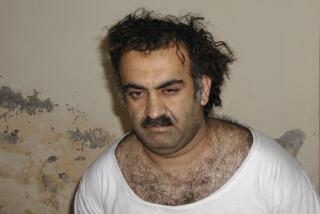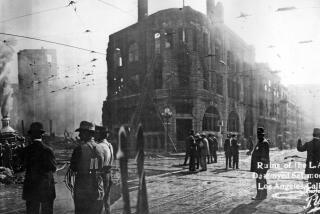Yousef, Driver Guilty in Trade Center Bombing
- Share via
NEW YORK — A federal court jury in Manhattan on Wednesday found Ramzi Ahmed Yousef guilty of masterminding the 1993 bombing of the World Trade Center and convicted a co-defendant on charges that he drove an explosives-laden van into the basement garage of the complex.
During the trial, prosecutors portrayed Yousef as one of the most sinister terrorists in history and told the jury that he had hoped to topple one of the trade center’s twin 110-story towers into the other like giant dominoes, killing as many as 250,000 people.
The motive, government lawyers said, was to punish the United States for its support for Israel.
The attack on Feb. 23, 1993, killed six people, injured 1,000 and shattered the myth that the nation was exempt from terrorism.
The verdict against Yousef, 29, and Eyad Ismoil, 26, came on the third day of deliberations. Both face possible life in prison.
Yousef, who appeared relaxed throughout much of the trial, seemed to wince, then dropped his head as the verdicts were read. Ismoil, who cried at his initial court appearance two years ago, displayed no emotion.
Following announcement of the verdict, the State Department warned Americans traveling abroad “that the potential exists for retaliation by Yousef’s sympathizers against American interests.” Yousef identifies himself as a Pakistani.
“While we have no specific threat information, American citizens traveling abroad should pay close attention to their personal security practices overseas in light of the potential threat,” the statement said.
The advice carried heightened resonance because of the fatal attack Wednesday on four American oil company employees in Karachi, Pakistan. There was speculation that attack might be in retaliation for Monday’s conviction in a U.S. court of Pakistani Mir Amal Kasi for the 1993 killing of two CIA workers.
In an earlier trial, Yousef was found guilty of plotting to blow up a dozen U.S. airliners in 24 hours of terror over the Pacific. He is awaiting sentencing in that case.
Yousef and Ismoil fled New York City the night of the bombing. The U.S. government posted a $2-million reward for the man prosecutors described as the architect of the attack, and Yousef was captured in Pakistan in 1995. Ismoil was seized the same year in Jordan.
Prosecutors charged that after the blast, Yousef watched smoke pouring from the twin towers from a spot on the New Jersey waterfront.
*
Agents who rode with Yousef during the flight from Pakistan told the jury that he said he had considered a poison gas attack on the World Trade Center but decided it would be too costly.
“Yousef bragged to the agents who brought him over here what he did,” charged Assistant U.S. Atty. David N. Kelley, who told the jurors the defendant had expressed regret that he didn’t kill enough people.
“These defendants bombed the World Trade Center because of their own prejudice and their own hatred for Israel,” said another prosecutor, Assistant U.S. Atty. Lev Dassin. “The defendants thought they were above the law.”
During more than two months of testimony by more than 100 witnesses, government lawyers presented chemical evidence, reports of residue and fingerprints found at bomb-making sites in New Jersey, statements from explosives experts, telephone receipts and other evidence detailing the plot.
Jurors learned that Yousef and another companion arrived at New York’s John F. Kennedy International Airport on Sept. 1, 1992, and that in November, Yousef, using an alias, ordered and paid for urea and nitric acid, components of the bomb.
Prosecutors charged that Yousef and other plotters mixed chemicals to produce explosives in a Jersey City, N.J., apartment and a nearby storage shed and that he conferred with Ismoil by phone before Ismoil traveled to New York from Dallas on Feb. 9, 1993.
The day before the blast, prosecutors said, Yousef and others loaded three tanks of hydrogen gas--an ingredient of the bomb--into a rented Ryder van. Government lawyers said the van, with Ismoil at the wheel, was driven the next day into the garage area beneath the Vista Hotel, situated in the trade center complex.
“The last time that these two people were sitting next to each other before they came to this courtroom was that day in the van,” Kelley told the jurors. “Picture them getting in the back of that van and lighting a fuse.”
Kelley charged that the bomb exploded moments later.
He said Ismoil’s fingerprints were recovered from the Jersey City apartment where portions of the bomb were mixed.
Prosecutors charged that hours after the explosion, Yousef, using an airline ticket in the name of an alias, traveled from Kennedy Airport to Karachi. The same evening, Ismoil boarded a flight to Amman, Jordan.
Unlike his previous trial on plotting to blow up the airliners, Yousef did not act as his own lawyer.
His attorney, Roy R. Kulcsar, told the jury during closing arguments that the government failed to prove its case. He charged that ammonium nitrate, an alleged ingredient of the bomb “did not have the detonation velocity to blow up the World Trade Center.”
Kulcsar suggested that agents fabricated evidence and lied on the witness stand, particularly about Yousef’s alleged confession on the flight back from Pakistan.
*
“Ramzi Yousef is an unpopular defendant. But this system is based on providing a fair trial to unpopular defendants,” Kulcsar said.
Ismoil’s lawyer challenged the government’s claim that his client was a close friend of Yousef and that he was a terrorist.
“Where is the evidence of that? There is none,” Louis R. Aidala told the jury.
Aidala said Yousef had fooled Ismoil into driving the explosives-laden van into the World Trade Center by claiming it was filled with cleaning solvents.
In a previous trial, four other trade center defendants were convicted and sentenced to terms of 240 years each in federal prison.
Times wire services contributed to this story.
More to Read
Sign up for Essential California
The most important California stories and recommendations in your inbox every morning.
You may occasionally receive promotional content from the Los Angeles Times.










